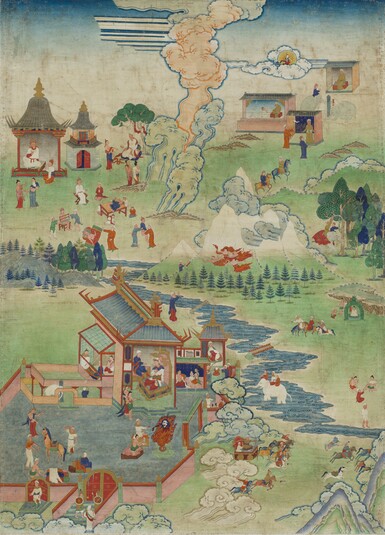
Item: Shakyamuni Buddha - Avadana (teaching stories)
| Origin Location | Tibet |
|---|---|
| Date Range | 1800 - 1899 |
| Lineages | Karma (Kagyu) and Buddhist |
| Material | Ground Mineral Pigment on Cotton |
| Collection | Private |
Classification: Person
Appearance: Buddha
Gender: Male
Avadana Painting #2 containing stories #1-3. From a set of 23 compositions and 108 stories. This set of Avadana paintings, original composition or copies, was conceived and sponsored by Situ Panchen Chokyi Jungne (1700-1774). From the first set of paintings numerous copies were later made. (See other compositions compiled from various sets).
This particular composition is very finely done. Each of the three stories are identified by a Tibetan inscription along with a number reference.
(1) The Awakening of King Prabhasa.
(2) The Generosity of King Srisena.
(3) King Manicuda's Perfection of Giving.
There are numerous ways in which the Avadana teaching stories have been illustrated in art. In the New Menri style of painting, beginning in the 17th century, there are at least two methods of composition based on emphasizing different characters and meanings from the 108 avadana stories. The painting style emphasized at Palpung Monastery, founded by Situ Panchen Chokyi Jungne in the mid 18th century, follows in the Kham Style (kham dri) and places the narrative stories on a much more open landscape compared with the Central Tibetan New Menri Style of painting.
There are a total of twenty-three paintings in the set. The first and last paintings do not contain any of the 108 narrative stories. The first painting in the set is of Buddha Shakyamuni and the last painting in the set is a portrait of Situ Panchen himself. (See a sequential list of the paintings and story numbers).
Jeff Watt 4-2000 [updated 1-2014]
[Story names from Leaves of the Heaven Tree, the Great Compassion of the Buddha by Padma Chopel, 19th century. (Based on the Bodhisattvavadanakalpata of Kshemendra, 11th century). Translated by Deborah Black. Berkeley: Dharma Publishing, 1997.]
Painting Set: Avadana, Palpung Style (Gandharva Set)
Painting Set: Avadana Composition (Situ Panchen Design) Main Page


